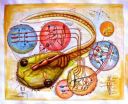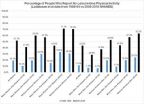(Press-News.org) The full circumstances of U.S. soldier Bowe Bergdahl's captivity have yet to be revealed. During his tour of duty in Afghanistan in 2009, Bergdahl was captured by the Taliban and held in captivity for five years until a controversial prisoner exchange led to his release on May 31. Bergdahl has been accused of deserting his post and advocating the release of Afghani prisoners.
"We do know that he suffered horrific conditions, tortured and kept in a metal cage in darkness for weeks on end," said Prof. Zahava Solomon, an Israel Prize laureate, Professor of Social Work and Psychiatric Epidemiology at Tel Aviv University's School of Social Work, and head of the newly founded Center of Excellence for Mass Trauma Research, established by the Israel Science Foundation. "His identification with the enemy could be seen as a form of Stockholm Syndrome, according to which tortured individuals identify with their perpetrators and take on their beliefs as a means of survival and empowerment. In a way, it is reminiscent of victims of child abuse, who may identify with their parents and continue the cycle of abuse as adults themselves.
"On the other hand, maybe he really was a conscientious objector, as some have said, having high ideals and high morals, and he started to identify with the people he saw as victims – vulnerable locals in poor conditions," Prof. Solomon says. "It is impossible to say conclusively."
In a new study conducted with Dr. Sharon Dekel of Harvard University's Department of Psychiatry and slated for publication in the Journal of Psychiatric Research, Prof. Solomon examines the co-morbid effects of war captivity and war trauma on prisoners of war. While symptoms of psychological illness are often pigeon-holed as specific individual disorders, Prof. Solomon argues against a narrow "tunnel vision" in treating POWs such as Bergdahl, who remains in rehabilitation.
A uniquely large sample
Prof. Solomon's new study follows the progress of several hundred ex-prisoners of war captured by the Syrians and Egyptians in the 1973 Yom Kippur War, with a specific eye toward the co-morbid interplay between Post-Traumatic Stress Disorder (PTSD) and depressive symptoms. These former combat soldiers were held captive for between one and nine months, interrogated under horrific conditions, electrocuted, raped, burned with cigarettes, told Israel had been conquered, and placed in solitary confinement.
Prof. Solomon has treated the same subjects – hundreds of Israel Defense Forces soldiers captured during Israel's 1973 Yom Kippur War – over more than 40 years. The POWs, their spouses, and their children were interviewed and observed at three specific points of time (1991, 2003, 2008) over 17 years, utilizing diagnostic tools and questionnaires. Two groups of combat veterans, 275 former prisoners of war (ex-POWS) and matched combatants (controls), were assessed.
Prof. Solomon found that while depression and PTSD seem to be different long-term manifestations of traumatic stress, they are both parts of a common general traumatic stress construct. "Despite the fact that they were released 40 years ago, these men feel and behave as if they are still in captivity," said Prof. Solomon. "With PTSD, they have recurrent nightmares, are startled easily by noise, triggered by anything in the news or media reminiscent of their experiences, abusive to their spouses and children, re-enact their trauma and are overprotective. Meanwhile, they also exhibit clear depressive symptoms."
No silver bullet
Statistical analysis from the study indicated that PTSD increased in ex-POWs over time, while it remained stable among traumatized ex-combatants. The researchers observed a clear relationship between PTSD and depression, with one disorder mediating the symptoms of the other at different points in time.
"The effect of psychological trauma is like cancer – it metastasizes," said Prof. Solomon. "You cannot treat a person only according to PTSD, an anxiety disorder, or depression, an effective disorder, because then the treatment itself becomes ineffective. Sometimes they overlap, but they are also quite different. This is a major challenge for clinicians, who must not be blinded or restricted by their textbook categories. There is no silver bullet, unfortunately, but it is crucial to treat people accurately and with sensitivity, according to current knowledge, and continue the research to enable more effective treatment."
INFORMATION:
American Friends of Tel Aviv University supports Israel's leading, most comprehensive and most sought-after center of higher learning, Tel Aviv University (TAU). Rooted in a pan-disciplinary approach to education, TAU is internationally recognized for the scope and groundbreaking nature of its research and scholarship — attracting world-class faculty and consistently producing cutting-edge work with profound implications for the future. TAU is independently ranked 116th among the world's top universities and #1 in Israel. It joins a handful of elite international universities that rank among the best producers of successful startups.
For a holistic approach to POW trauma
Tel Aviv University researcher cautions against psychological 'tunnel vision'
2014-07-07
ELSE PRESS RELEASES FROM THIS DATE:
Patient patience and pandemics
2014-07-07
Allowing patients to choose which hospital they attend when suffering illness during a pandemic rather than assigning them to a specific healthcare facility is appealing to patients during such a crisis. However, such a patient-centric hospital capacity management is conventionally viewed as inefficient system-wide. According to research published in the International Journal of Mathematics in Operational Research, an incentive-based approach for hospital capacity management can not only accomplish a high efficiency for a concerned hospital system but satisfy patients' ...
World Cup chemistry: The science behind the 'brazuca' (video)
2014-07-07
WASHINGTON, July 7, 2014 — The World Cup final is almost here, and no matter which two teams meet for the title match, there's one thing they'll both need to win: the ball. This week, Reactions examines the chemistry that goes into making the "brazuca," and what makes it different from most other soccer balls out there. The video is available at https://www.youtube.com/watch?v=1XNTfslUzt8.
INFORMATION:
Subscribe to the series at Reactions YouTube, and follow us on Twitter @ACSreactions to be the first to see our latest videos.
The American Chemical Society is a nonprofit ...
Infant toenails reveal in utero exposure to low-level arsenic, Dartmouth study finds
2014-07-07
Infant toenails are a reliable way to estimate arsenic exposure before birth, a Dartmouth College study shows.
The findings appear in the Journal of Exposure Science & Environmental Epidemiology. A PDF of the study is available on request.
A growing body of evidence suggests that in utero and early-life exposure to arsenic may have detrimental effects on children, even at the low to moderate levels common in the United States and elsewhere. The fetus starts to develop toenails during the first trimester, making them an accurate measure of exposure to arsenic during ...
GVSU researchers find moral beliefs barrier to HPV vaccine
2014-07-07
GRAND RAPIDS, Mich. — A survey of first-year Grand Valley State University students showed the biggest barrier to receiving a Human Papillomavirus (HPV) vaccine was moral or religious beliefs, or a perceived promotion of sexual behavior, according to graduate physician assistant researchers.
Physician Assistant Studies majors Jamie Phillipich and Margie Webb surveyed 1,000 incoming students last fall as part of their master's research project. They assessed the influence media has on the perception of HPV and vaccine compliance, and presented their findings at the Annual ...
Dodging dots helps explain brain circuitry
2014-07-07
PROVIDENCE, R.I. [Brown University] — A neuroscience study provides new insight into the primal brain circuits involved in collision avoidance, and perhaps a more general model of how neurons can participate in networks to process information and act on it.
In the study, Brown University neuroscientists tracked the cell-by-cell progress of neural signals from the eyes through the brains of tadpoles as they saw and reacted to stimuli including an apparently approaching black circle. In so doing, the researchers were able to gain a novel understanding of how individual ...
Satellites reveal possible catastrophic flooding months in advance, UCI finds
2014-07-07
Irvine, Calif., July 7, 2014 – Data from NASA satellites can greatly improve predictions of how likely a river basin is to overflow months before it does, according to new findings by UC Irvine. The use of such data, which capture a much fuller picture of how water is accumulating, could result in earlier flood warnings, potentially saving lives and property.
The research was published online Sunday in the journal Nature Geoscience.
A case study of the catastrophic 2011 Missouri River floods showed that factoring into hydrologic models the total water storage information ...
Why 'whispers' among bees sometimes evolve into 'shouts'
2014-07-07
Let's say you're a bee and you've spotted a new and particularly lucrative source of nectar and pollen. What's the best way to communicate the location of this prize cache of food to the rest of your nestmates without revealing it to competitors, or "eavesdropping" spies, outside of the colony?
Many animals are thought to deter eavesdroppers by making their signals revealing the location or quality of resources less conspicuous to outsiders. In essence, they've evolved "whispers" in their signals to counter eavesdropping.
But some species of bees in Brazil do the exact ...
Obesity, large waist size risk factors for COPD
2014-07-07
Obesity, especially excessive belly fat, is a risk factor for chronic obstructive pulmonary disease (COPD), according to an article in CMAJ (Canadian Medical Association Journal)
Excessive belly fat and low physical activity are linked to progression of the disease in people with COPD, but it is not known whether these modifiable factors are linked to new cases.
A team of researchers in Germany and the United States looked at the relationship of waist and hip circumference, body mass index (BMI) and physical activity levels to new cases of COPD in a large group of men ...
Less exercise, not more calories, responsible for expanding waistlines
2014-07-07
Philadelphia, PA, July 7, 2014 – Sedentary lifestyle and not caloric intake may be to blame for increased obesity in the US, according to a new analysis of data from the National Health and Nutrition Examination Survey (NHANES). A study published in the American Journal of Medicine reveals that in the past 20 years there has been a sharp decrease in physical exercise and an increase in average body mass index (BMI), while caloric intake has remained steady. Investigators theorized that a nationwide drop in leisure-time physical activity, especially among young women, may ...
Mind the gap: Socioeconomic status may influence understanding of science
2014-07-07
MADISON — When it comes to science, socioeconomic status may widen confidence gaps among the least and most educated groups in society, according to a new study by researchers at the University of Wisconsin-Madison's Science, Media and the Public research group.
The findings, published in June in the journal Science Communication, show that similar levels of attention to science in newspapers and on blogs can lead to vastly different levels of factual and perceived knowledge between the two groups.
Notably, frequent science blog readership among low socioeconomic-status ...
LAST 30 PRESS RELEASES:
Tracing the quick synthesis of an industrially important catalyst
New software sheds light on cancer’s hidden genetic networks
UT Health San Antonio awarded $3 million in CPRIT grants to bolster cancer research and prevention efforts in South Texas
Third symposium spotlights global challenge of new contaminants in China’s fight against pollution
From straw to soil harmony: International team reveals how biochar supercharges carbon-smart farming
Myeloma: How AI is redrawing the map of cancer care
Manhattan E. Charurat, Ph.D., MHS invested as the Homer and Martha Gudelsky Distinguished Professor in Medicine at the University of Maryland School of Medicine
Insilico Medicine’s Pharma.AI Q4 Winter Launch Recap: Revolutionizing drug discovery with cutting-edge AI innovations, accelerating the path to pharmaceutical superintelligence
Nanoplastics have diet-dependent impacts on digestive system health
Brain neuron death occurs throughout life and increases with age, a natural human protein drug may halt neuron death in Alzheimer’s disease
SPIE and CLP announce the recipients of the 2025 Advanced Photonics Young Innovator Award
Lessons from the Caldor Fire’s Christmas Valley ‘Miracle’
Ant societies rose by trading individual protection for collective power
Research reveals how ancient viral DNA shapes early embryonic development
A molecular gatekeeper that controls protein synthesis
New ‘cloaking device’ concept to shield sensitive tech from magnetic fields
Researchers show impact of mountain building and climate change on alpine biodiversity
Study models the transition from Neanderthals to modern humans in Europe
University of Phoenix College of Doctoral Studies releases white paper on AI-driven skilling to reduce burnout and restore worker autonomy
AIs fail at the game of visual “telephone”
The levers for a sustainable food system
Potential changes in US homelessness by ending federal support for housing first programs
Vulnerability of large language models to prompt injection when providing medical advice
Researchers develop new system for high-energy-density, long-life, multi-electron transfer bromine-based flow batteries
Ending federal support for housing first programs could increase U.S. homelessness by 5% in one year, new JAMA study finds
New research uncovers molecular ‘safety switch’ shielding cancers from immune attack
Bacteria resisting viral infection can still sink carbon to ocean floor
Younger biological age may increase depression risk in older women during COVID-19
Bharat Innovates 2026 National Basecamp Showcases India’s Most Promising Deep-Tech Ventures
Here’s what determines whether your income level rises or falls
[Press-News.org] For a holistic approach to POW traumaTel Aviv University researcher cautions against psychological 'tunnel vision'


